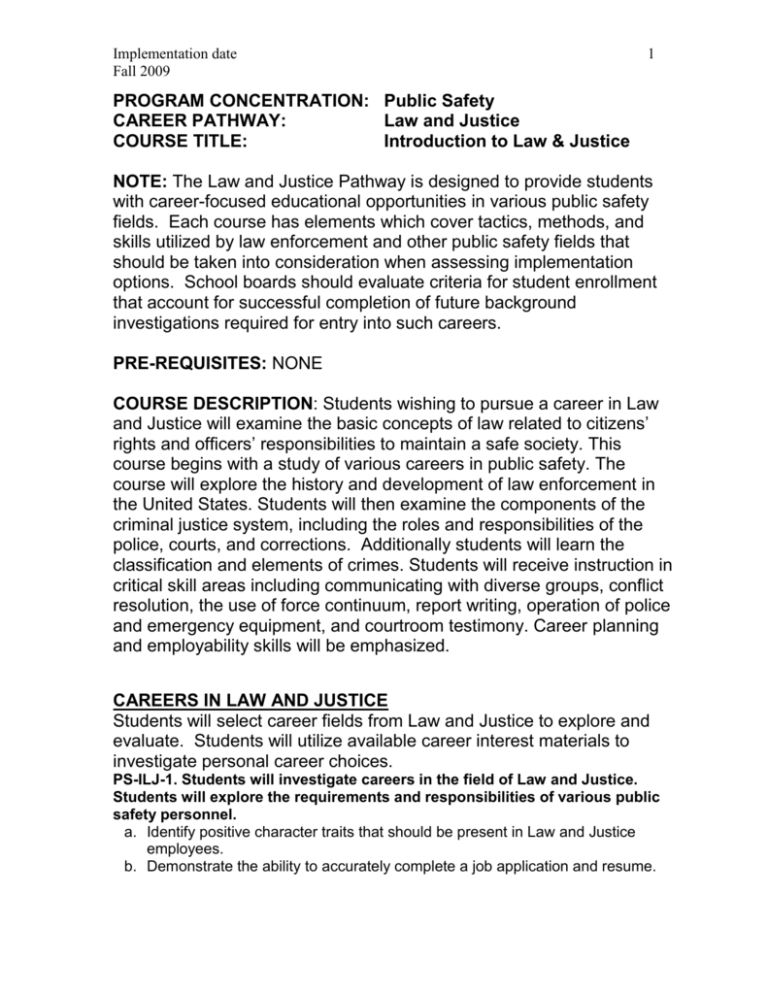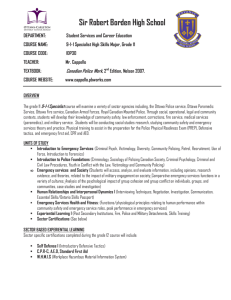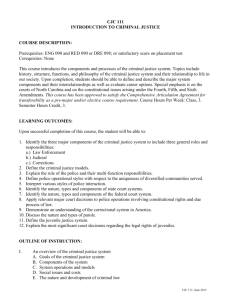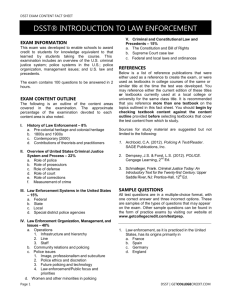careers in law and justice
advertisement

Implementation date Fall 2009 1 PROGRAM CONCENTRATION: Public Safety CAREER PATHWAY: Law and Justice COURSE TITLE: Introduction to Law & Justice NOTE: The Law and Justice Pathway is designed to provide students with career-focused educational opportunities in various public safety fields. Each course has elements which cover tactics, methods, and skills utilized by law enforcement and other public safety fields that should be taken into consideration when assessing implementation options. School boards should evaluate criteria for student enrollment that account for successful completion of future background investigations required for entry into such careers. PRE-REQUISITES: NONE COURSE DESCRIPTION: Students wishing to pursue a career in Law and Justice will examine the basic concepts of law related to citizens’ rights and officers’ responsibilities to maintain a safe society. This course begins with a study of various careers in public safety. The course will explore the history and development of law enforcement in the United States. Students will then examine the components of the criminal justice system, including the roles and responsibilities of the police, courts, and corrections. Additionally students will learn the classification and elements of crimes. Students will receive instruction in critical skill areas including communicating with diverse groups, conflict resolution, the use of force continuum, report writing, operation of police and emergency equipment, and courtroom testimony. Career planning and employability skills will be emphasized. CAREERS IN LAW AND JUSTICE Students will select career fields from Law and Justice to explore and evaluate. Students will utilize available career interest materials to investigate personal career choices. PS-ILJ-1. Students will investigate careers in the field of Law and Justice. Students will explore the requirements and responsibilities of various public safety personnel. a. Identify positive character traits that should be present in Law and Justice employees. b. Demonstrate the ability to accurately complete a job application and resume. Implementation date Fall 2009 2 c. Demonstrate knowledge and skills required to seek, apply, and accept employment. d. Design a portfolio to apply for jobs in Law and Justice. e. Apply acquired skills in an interview setting. f. Investigate personal career interests. Academic Standards: ELA10W3 The student uses research and technology to support writing ELA12C1 The student demonstrates understanding and control of the rules of the English language, realizing that usage involves the appropriate application of conventions and grammar in both written and spoken formats. ELA12LSV1 The student participates in student-to-teacher, student-to-student, and group verbal interactions. ELA10RC3 The student acquires new vocabulary in each content area and uses it correctly. OVERVIEW OF THE CRIMINAL JUSTICE SYSTEM Students will be introduced to the complex role of government in a democratic society and the rights and responsibilities of its citizens. They will explore the history and evolution of law enforcement in the United States. Roles and responsibilities of different emergency service agencies and systems will be evaluated. PS-ILJ-2. Students will describe the relationship between police, courts, and corrections. a. Demonstrate a working knowledge of the criminal justice process, and explain how different agencies work together. b. Identify jurisdictional and venue issues that may arise when different emergency service agencies work together and provide suggestions for resolving them. c. Describe the roles and responsibilities of private security agencies and explain how they differ from public law enforcement agencies. d. Discuss the importance of all public safety related agencies working together to serve and protect the public. e. Describe the roles and responsibilities of local, county, state, and federal agencies. f. Describe and apply knowledge of how the United States legal system works. Academic Standards: ELA10RC3 The student acquires new vocabulary in each content area and uses it correctly. SSCG1. The student will demonstrate knowledge of the political philosophies that shaped the development of United States constitutional government. SSCG3. The student will demonstrate knowledge of the United States Constitution. Implementation date Fall 2009 3 SSCG4. The student will demonstrate knowledge of the organization and powers of the national government. SSCG5. The student will demonstrate knowledge of the federal system of government described in the United States Constitution. PS-ILJ-3. Students will investigate the dangers associated with various Law and Justice professions. a. Investigate universal precautions and blood born pathogens. b. Identify hazardous materials and describe the special methods required for handling them. c. Maintain a safe work environment. Academic Standards: SB2 Students will analyze how biological traits are passed on to successive generations. SB5 Students will evaluate the role of natural selection in the development of the theory of evolution. BASIC CRIMINAL AND CONSTITUTIONAL LAW Students will compare and contrast America’s criminal and civil court structures, systems, and processes. Students will be introduced to the American legal system and basic legal concepts. PS-ILJ-4. Students will analyze the structure of the government and the court system. a. Examine the structure and processes of the criminal justice system. b. Differentiate between civil law and criminal law. c. Explore the rights of citizens guaranteed by the United States. d. Explain the powers granted to the police and the restrictions placed upon them by the respective constitutions and amendments. e. Explore a range of constitutional and non-constitutional issues facing today’s law enforcement officers. f. Argue the application of constitutional interpretation to specific cases. Academic Standards: ELA10RC2 The student participates in discussions related to curricular learning in all subject areas. SSCG5 The student will demonstrate knowledge of the federal system of government described in the United States Constitution. SSUSH5 The student will explain specific events and key ideas that brought about the adoption and implementation of the United States Constitution. SSCG16 The student will demonstrate knowledge of the operation of the federal judiciary. SSCG17 The student will demonstrate knowledge of the organization and powers of state and local government described in the Georgia Constitution Implementation date Fall 2009 4 PS-ILJ-5. Students will identify criminal laws used frequently in the criminal justice system. a. Describe how laws are classified. b. Describe a crime that includes all ideal elements. c. Justify selected charges that merit prosecution in given scenarios. Academic Standards: ELA10RL5 The student understands and acquires new vocabulary and uses it correctly in reading and writing. ELA12LSV1 The student participates in student-to-teacher, student-to-student, and group verbal interactions. ELA12LSV2 The student formulates reasoned judgments about written and oral communication in various media genres. The student delivers focused, coherent, and polished presentations that convey a clear and distinct perspective, demonstrate solid reasoning, and combine traditional rhetorical strategies of narration, exposition, persuasion, and description. SSCG21 The student will demonstrate knowledge of criminal activity. SSCG22 The student will demonstrate knowledge of the criminal justice process. POLICE REPORTS Students will become familiar with oral and written communications utilized in law enforcement. PS-ILJ-6. Students will demonstrate the ability to accurately complete various law enforcement reports and documents. a. Demonstrate the ability to communicate clearly and professionally. b. Utilize field note-taking and report-writing skills to complete police incident reports. c. Demonstrate the ability to write comprehensive and accurate police reports answering the basic questions of who, what, where, when, how, and why. d. Demonstrate professionalism in communicating with others. e. Apply active listening skills to obtain and clarify information. f. Apply reading strategies to learn vocabulary, technical concepts, and follow directions. g. Demonstrate proficiency in interpreting verbal and non-verbal communication. h. Write a clear and concise narrative report describing a criminal incident. i. Determine methods to document critical information in response to a criminal scenario. j. Gather facts, interview witnesses, and interrogate suspects in a mock crime scene. k. Create a written report from information collected at mock crime scene. Academic Standards: ELA10RL5 The student understands and acquires new vocabulary and uses it correctly in reading and writing. Implementation date Fall 2009 5 ELA12W1 The student produces writing that establishes an appropriate organizational structure, sets a context and engages the reader, maintains a coherent focus throughout, and signals a satisfying closure. ELA12C2 The student demonstrates understanding of manuscript form, realizing that different forms of writing require different formats. ELA12LSV1 The student participates in student-to-teacher, student-to-student, and group verbal interactions. ELA12LSV2 The student formulates reasoned judgments about written and oral communication in various media genres. The student delivers focused, coherent, and polished presentations that convey a clear and distinct perspective, demonstrate solid reasoning, and combine traditional rhetorical strategies of narration, exposition, persuasion, and description. USE OF FORCE Students will demonstrate an understanding of the continuum of force and how it applies to situations. Students will identify firearms, less-thanlethal weapons and self-defense methods used by peace officers. They will demonstrate understanding of precautions which should be taken when using force. PS-ILJ-7: Students will investigate how force is used by law and justice professionals. a. Discuss appropriate use of force in self-defense situations. b. Explain proper use of pain as a motivator to compliance. c. Discuss the fundamentals of self-defense. d. Explain skills in the lower and intermediate levels of force use. e. Identify less-than-lethal force options. f. Explain various locks, holds, and bars. g. Apply the use of force continuum to given scenarios. Academic Standards: SAP1. Students will analyze anatomical structures in relationship to their physiological functions. SAP2. Students will analyze the interdependence of the integumentary, skeletal, and muscular systems as these relate to the protection, support and movement of the human body. SAP3. Students will assess the integration and coordination of body functions and their dependence on the endocrine and nervous systems to regulate physiological activities. SAP4. Students will analyze the physical, chemical, and biological properties of process systems as these relate to transportation, absorption and excretion, including the cardiovascular, respiratory, digestive, excretory and immune systems. ELA12LSV1 The student participates in student-to-teacher, student-to-student, and group verbal interactions. Implementation date Fall 2009 6 APPROACH AND ARREST OF SUSPECTS Students will discuss the legality of arrests. Students will demonstrate proper handcuffing technique while demonstrating officer safety. PS-ILJ-8. Students will demonstrate proper protocol in communication, coordination, and control when approaching and arresting suspects. a. Articulate constitutional standards in arrests, frisks, and searches. b. Analyze risks in interacting with suspects. c. Demonstrate the use of communications with dispatch and other officers before, during, and after an interaction with a subject. d. Demonstrate proper use of handcuffing suspects in the kneeling and prone positions. e. Demonstrate the use of appropriate verbal commands. f. Discuss proper frisk and search procedures. Academic Standards: SAP2. Students will analyze the interdependence of the integumentary, skeletal, and muscular systems as these relate to the protection, support and movement of the human body. ELA10RC2 The student participates in discussions related to curricular learning in all subject areas. SSCG3 The student will demonstrate knowledge of the United States Constitution. PARTOL OPERATIONS Students will discuss the various types of patrol methods used in contemporary law enforcement. Students will explain proper police procedure in the approach of vehicles in unknown and high risk traffic stops. PS-ILJ-9. Students will analyze the purpose and importance of patrol operations within a police agency. a. Discuss the importance of patrol. b. Explain the different types of patrols in their area. c. Explain the Kansas City Experiment. d. Explain preventive, directed, aggressive patrol. e. Describe and explain how foot, motorcycle, mounted, bike and cruiser patrol are components of community response. Academic Standards: ELA10RC2 The student participates in discussions related to curricular learning in all subject areas. ELA10RC3 The student acquires new vocabulary in each content area and uses it correctly. Implementation date Fall 2009 7 SSUSH23 The student will describe and assess the impact of political developments between 1945 and 1970. SSUSH24 The student will analyze the impact of social change movements and organizations of the 1960s. PS-ILJ-10. Students will demonstrate understanding of police response to both unknown and high risk traffic stops. a. Explain the risks associated with traffic stops. b. Describe how vehicle alignment improves officer safety. c. Discuss how an officer should approach a vehicle in an unknown risk traffic stop. d. Formulate a plan for how officers should respond to a high risk traffic stop incorporating various environmental conditions as well as limitations on available resources. Academic Standards: ELA10RC4 The student establishes a context for information acquired by reading across subject areas. ELA12LSV1 The student participates in student-to-teacher, student-to-student, and group verbal interactions. SSCG3 The student will demonstrate knowledge of the United States Constitution. TRAFFIC CODES AND INVESTIGATIONS Students will develop a basic working knowledge of various traffic codes. Students will participate in a mock traffic investigation. PS-ILJ-11. Students will demonstrate understanding of traffic enforcement and investigations. a. Understand the importance of effective and traffic enforcement as it relates to loss of life, serious injury, and property damage. b. Discuss the functions of traffic patrol units. c. Justify the choice of traffic code applied to a given traffic incident. d. Understand the basics of crash scene investigation. e. Complete a traffic crash report. f. Write accurate and complete traffic citations. g. Discuss the difference between a citation and an arrest as it relates to traffic code enforcement. h. Assess a mock crash scene and respond accordingly. i. Formulate a plan to properly document the mock crash scene using appropriate techniques and paperwork. Academic Standards: MM1A1. Students will explore and interpret the characteristics of functions, using graphs, tables, and simple algebraic techniques. MM1A3. Students will solve simple equations. MM4P1. Students will solve problems (using appropriate technology). Implementation date Fall 2009 8 MM4P2. Students will reason and evaluate mathematical arguments. MM4P3. Students will communicate mathematically. MM4P4. Students will make connections among mathematical ideas and to other disciplines. SPS8. Students will determine relationships among force, mass, and motion. SP3. Students will evaluate the forms and transformations of energy. COMMUNITY POLICING, CONFLICT RESOLUTION AND CULTURAL DIVERSITY Students will apply the ideas of Community Policing to a given scenario. Students will demonstrate conflict resolution techniques in role play. Students will explore the cultural diversity that exists in today’s complex society. Students will devise a plan to respond to needs in a mock community. PS-ILJ-12. Students will demonstrate a basic understanding of community policing. a. Describe attitudes of the public toward police. b. Identify characteristics of police work. c. Distinguish among three operational styles in policing. d. List the three major functions of police departments. e. Explain the main components of community policing. f. Identify the four steps in a community policing approach to problem solving. g. Discuss some of the unresolved issues concerning policing. h. Demonstrate the ability to identify problems in a criminal justice scenario and use critical thinking skills to lawfully resolve them. i. Demonstrate the ability to solve criminal justice problems using ethical solutions. Academic Standards: SSCG22 The student will demonstrate knowledge of the criminal justice process. ELA10RL5 The student understands and acquires new vocabulary and uses it correctly in reading and writing. ELA10RC2 The student participates in discussions related to curricular learning in all subject areas. ELA10RC3 The student acquires new vocabulary in each content area and uses it correctly. PS-ILJ-13. Students will utilize conflict resolution in role play. a. Identify a variety of mediation and conflict resolution skills used to effectively resolve criminal justice issues. b. Demonstrate the ability to use critical thinking skills as a team member to formulate solutions to problems. c. Assess a given role play and determine the best response. Implementation date Fall 2009 9 Academic Standards: ELA12LSV1 The student participates in student-to-teacher, student-to-student, and group verbal interactions. PS-ILJ-14. Students will analyze cultural differences that may have an impact on participants in the criminal justice system. a. Explain the importance of sensitivity to situations involving cultural diversity. b. Compare the cultures of major immigrant groups. c. Describe subcultures of American culture that Law and Justice professionals interact on a regular basis. Academic Standards: SSWG2 The student will explain the cultural aspects of geography. SSWG8 The student will describe the interaction of physical and human systems that have shaped contemporary Canada and the United States. ELA12W3 The student uses research and technology to support writing. SENTENCING AND CORRECTIONAL ISSUES Students will demonstrate an understanding of the sentencing process in a criminal case. Students will debate the philosophical perspectives in American punishment. Additionally, students will discuss the many issues surrounding corrections. PS-ILJ-15. Students will explain the various purposes and different types of sentences. a. Identify the general factors influencing a judge’s sentencing decision. b. Describe how judges vary sentences to fit the crime and offender. c. Explain the three basic types of sentences. d. Understand the rationales or justifications for criminal punishment. e. Explain the purposes of pre-sentence investigation reports. f. Summarize the arguments in support of and in opposition the Three Strikes Law. Academic Standard: SSCG16 The student will demonstrate knowledge of the operation of the federal judiciary. SSCG22 The student will demonstrate knowledge of the criminal justice process. SSUSH24 The student will analyze the impact of social change movements and organizations of the 1960s. ELA10RC2 The student participates in discussions related to curricular learning in all subject areas. ELA12LSV1 The student participates in student-to-teacher, student-to-student, and group verbal interactions. PS-ILJ-16. Students will describe American corrections. a. Describe correctional officer duties. b. Explain how today’s inmate society differs from those of the past. Implementation date Fall 2009 10 c. Identify prisoners’ rights. d. Explain methods of inmate released. e. Summarize what recidivism research reveals about the success of the prison in achieving deterrence and rehabilitation. f. Identify the circumstances for which capitol punishment might be applied. g. Debate issues related to capital punishment. Academic Standard: ELA12W1 The student produces writing that establishes an appropriate organizational structure, sets a context and engages the reader, maintains a coherent focus throughout, and signals a satisfying closure. ELA12W3 The student uses research and technology to support writing. ELA12C1 The student demonstrates understanding and control of the rules of the English language, realizing that usage involves the appropriate application of conventions and grammar in both written and spoken formats. SSCG22 The student will demonstrate knowledge of the criminal justice process. AGENCY ADMINISTRATION Students will explain the basic purposes of policing in democratic societies. Students will describe the different types of organizational structures in a typical police department. PS-ILJ-17. Students will demonstrate a basic understanding of the police mission, operational strategies, police management and styles. a. Discuss the core operational strategies of police departments. b. Demonstrate a basic understanding of the policing rank structure. c. Apply event management and crisis emergency protocols to a scenario. d. Discuss the need for police management and accountability. Academic Standard: ELA10RC3 The student acquires new vocabulary in each content area and uses it correctly. ELA10RC4 The student establishes a context for information acquired by reading across subject areas. SSCG3 The student will demonstrate knowledge of the United States Constitution. ETHICS IN LAW AND JUSTICE Students will discuss police deviance and the role discretion plays in police corruption. They will also identify issues that have impact the police the public perception of police. PS-ILJ-18. Students will investigate the role of ethics in policing. a. Identify unethical and illegal actions in police work. b. Discuss the law enforcement officers' code of ethics. c. Explore the various reasons for police corruption. Implementation date Fall 2009 11 d. Appraise the forms of police misconduct other than corruption. e. Identify the effects of police corruption and brutality. Academic Standard: ELA10RC2 The student participates in discussions related to curricular learning in all subject areas. ELA10RC3 The student acquires new vocabulary in each content area and uses it correctly. SSCG6 The student will demonstrate knowledge of civil liberties and civil rights. SSCG15 The student will explain the functions of the departments and agencies of the federal bureaucracy. SSCG16 The student will demonstrate knowledge of the operation of the federal judiciary.









